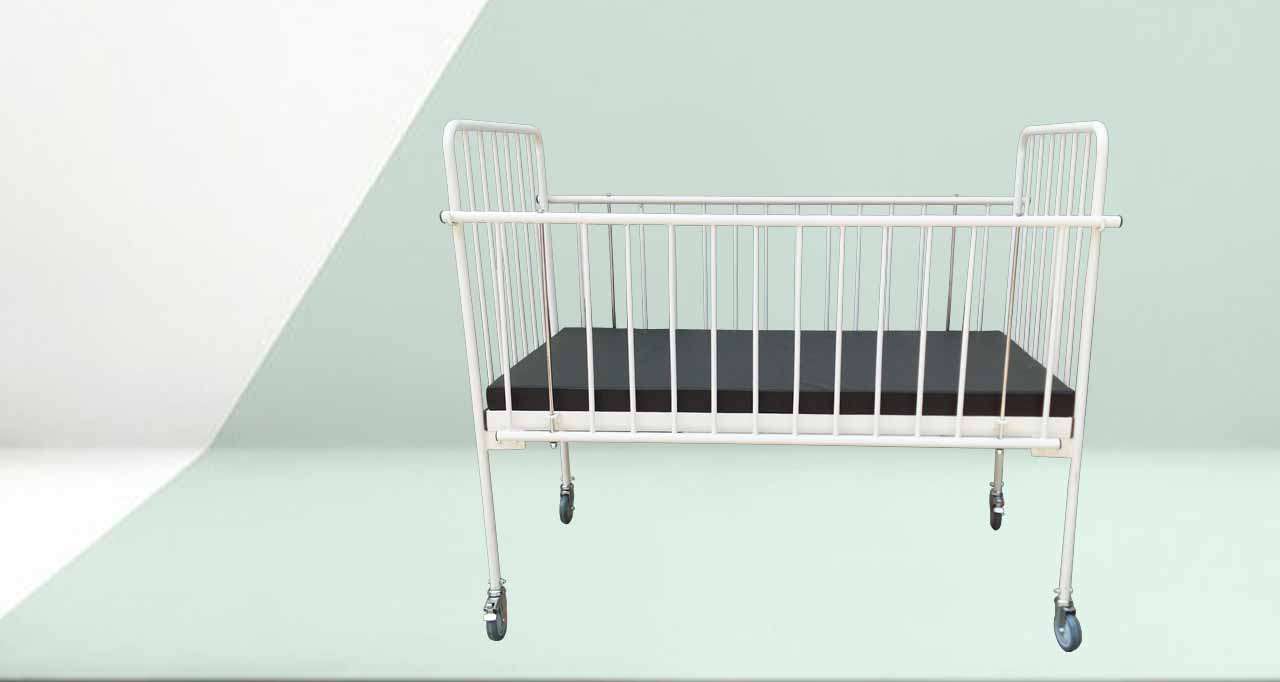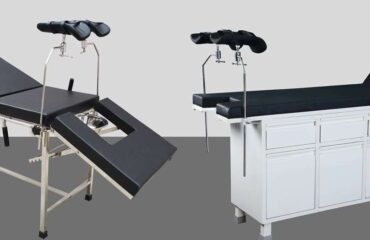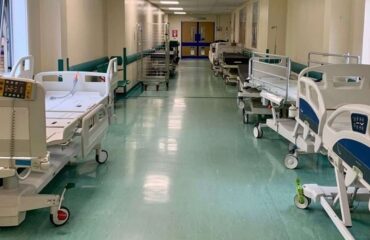A paediatric hospital bed is a specially designed hospital bed tailored to meet the unique needs of infants, toddlers, and children up to adolescence who require inpatient medical care. These beds differ significantly from standard adult hospital beds in terms of size, safety features, design, and adjustability, to ensure both effective medical treatment and child safety.

Key Features of a Paediatric Hospital Bed
Smaller Dimensions
- Designed to fit the smaller stature of children.
- Typically, shorter and narrower than adult beds.
Adjustable Height and Positioning
- Head and foot sections can be raised or lowered.
- Some beds may also allow Trendelenburg (head down) or reverse Trendelenburg (feet down) positions.
Side Rails
- High, secure side rails prevent the child from falling out.
- Often come with vertical or horizontal bars, and may be collapsible or removable.
- Some models have lockable, transparent panels for better visibility.
Child-Safe Materials and Design
- Rounded edges to prevent injury.
- Use of non-toxic, easy-to-clean materials.
- Smooth surfaces with minimal pinch points.
Mobility
- Equipped with wheels and locking mechanisms for easy transport within the hospital.
- Pediatric-Friendly Appearance
- Often decorated with bright colors, cartoon characters, or playful designs to create a less intimidating hospital environment.
IV and Accessory Compatibility
- Includes IV pole mounts, oxygen cylinder holders, or other medical equipment attachments.
- Mattress Compatibility
- Fitted with pressure-relief mattresses sized specifically for children to prevent bedsores.
Mattress Compatibility
- Fitted with pressure-relief mattresses sized specifically for children to prevent bedsores.
Types of Paediatric Hospital Beds
Here are the detailed types of paediatric hospital beds, designed to suit the medical and comfort needs of infants, toddlers, and children of various age groups and conditions:
Pediatric Crib Beds (Infant/Toddler Beds)
These are similar in design to a baby crib but medically equipped for hospital use. Ideal for infants and toddlers (0–3 years).
Key Features:
- High, vertical side rails or clear panels.
- Enclosed design to prevent falls or climbing.
- Some have canopy tops or overhead frames for IV or monitors.
- Adjustable mattress platform height.
- Often include a child-friendly appearance.
Use Case:
- Neonatal and pediatric ICUs, recovery rooms, or general wards.
Junior Pediatric Beds
Scaled-down versions of adult hospital beds designed for young children and school-aged kids.
Key Features:
- Lower height and smaller frame than adult beds.
- Adjustable head and leg sections.
- Side rails that are higher than adult beds but lower than cribs.
- Manual or electric positioning.
Use Case:
- General pediatric wards, minor procedures, and post-operative care.
Pediatric Intensive Care Unit (PICU) Beds
Specialized beds for critically ill or injured children in intensive care settings.
Key Features:
- Full electric operation.
- Advanced positioning options (Trendelenburg, CPR function).
- Integrated monitoring device attachments.
- High safety rails, anti-entrapment designs.
- Accessory rails for multiple medical devices.
Use Case:
- Pediatric ICU, high-dependency units.
Electric Pediatric Hospital Beds
Electronically controlled beds suitable for children of varying ages, especially for those requiring long-term care or complex procedures.
Key Features:
- Motorized head, foot, and height adjustments via remote control.
- Battery backup for power failure.
- Side rails with child-safe lock mechanisms.
- Designed for both comfort and ease of medical access.
Use Case:
- Pediatric oncology, long-term rehab, chronic care facilities.
Manual Pediatric Hospital Beds
Cost-effective beds adjusted using manual cranks instead of electric motors.
Key Features:
- Adjustable height and mattress angles by manual levers.
- Strong steel construction.
- High side rails for safety.
- Basic design, suitable for general use.
Use Case:
- Rural hospitals, clinics with limited resources, temporary facilities.
Transport Pediatric Beds
- Specialized for safely moving pediatric patients within a hospital or between facilities.
Key Features:
- Lightweight and easy to maneuver.
- Safety belts and side rails.
- Locking wheels.
- May include IV poles and oxygen tank holders.
Use Case:
- Emergency departments, inter-ward transport, ambulances.
Pediatric Isolation Beds
- Used for children requiring infection control or isolation.
Key Features:
- Transparent enclosures or covers.
- Sealed or semi-sealed structures.
- Allows full visibility while protecting from airborne exposure.
Use Case:
- Infectious disease wards, ICU isolation units.
Benefits of Pediatric Hospital Beds
Here are the detailed benefits of pediatric hospital beds, which are specifically designed to cater to the unique needs of children in healthcare settings:
Enhanced Safety for Children
Why it matters:
Children—especially infants and toddlers—are naturally active, curious, and prone to movement, which increases the risk of falls or injuries.
Safety Features:
- High or enclosed side rails to prevent falling or climbing out.
- Rounded edges and smooth surfaces to avoid injuries.
- Non-toxic, antimicrobial materials.
- Locking wheels for stability during procedures or movement.
Benefit:
- Reduces the risk of accidental falls and injuries, ensuring child safety during treatment or rest.
Age-Appropriate Comfort and Sizing
Why it matters:
Children are not just “small adults”; their bodies and comfort needs differ significantly.
Design Aspects:
- Beds are scaled to fit different age groups—from infants to adolescents.
- Pressure-relieving pediatric mattresses for enhanced comfort.
- Adjustable height and angles for optimal positioning.
Benefit:
- Provides physical comfort and better rest, which supports faster healing and reduces stress.
Improved Emotional Well-being
Why it matters:
Hospitals can be intimidating for children. Familiar and friendly surroundings help reduce anxiety.
Child-Friendly Features:
- Bright colors, cartoons, and playful shapes.
- Transparent side panels to let children see parents or caregivers.
- Some models are decorated like cribs or playpens.
Easy and Safe Access for Medical Staff
Why it matters:
Doctors and nurses need quick and effective access to pediatric patients for routine checks, emergency care, or intensive procedures.
Operational Features:
- Adjustable height and position controls.
- Side rails that drop down or open.
- IV pole holders, oxygen tank hooks, and equipment compatibility.
Benefit:
Facilitates faster, safer, and more efficient care delivery.
Support for Family-Centered Care
Why it matters:
Family involvement in pediatric care significantly improves outcomes and emotional stability for the child.
Supportive Features:
- Clear visibility through transparent sides.
- Lower heights to allow interaction.
- Enough room near the bed for seating or parental presence.
Benefit:
Encourages parent-child bonding, reduces separation anxiety, and improves patient satisfaction.
Mobility and Emergency Readiness
Why it matters:
Children often require frequent movement between departments for tests or surgeries.
Functional Elements:
- Smooth-rolling, lockable wheels.
- Brakes for safety during transfer.
- Lightweight but stable design.
Benefit:
Makes internal transport safe and efficient without disturbing the child’s comfort or medical setup.
Versatile Adjustability for Clinical Needs
Why it matters:
Children may need to be positioned in specific ways for procedures, recovery, or respiratory support.
Adjustment Capabilities:
- Electric or manual elevation of head, foot, or whole bed.
- Trendelenburg and reverse Trendelenburg positions in ICU models.
- Built-in CPR functionality in advanced beds.
Benefit:
- Allows customized positioning for treatment, improving clinical outcomes and caregiver efficiency.
Infection Control and Hygiene
Why it matters:
Children are more vulnerable to infections during hospital stays.
Design Aspects:
- Use of antimicrobial, easy-to-clean materials.
- Removable mattresses for thorough disinfection.
- Fewer crevices where dirt can collect.
Benefit:
Supports hospital hygiene protocols and reduces hospital-acquired infections (HAIs).


